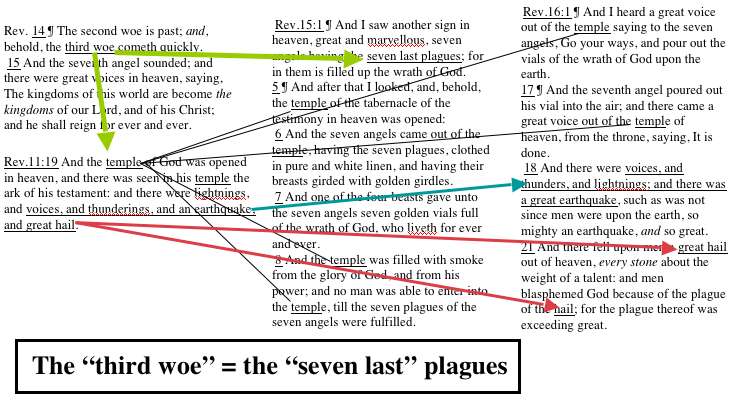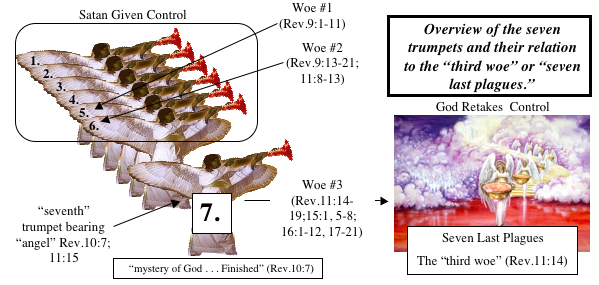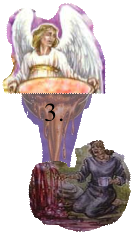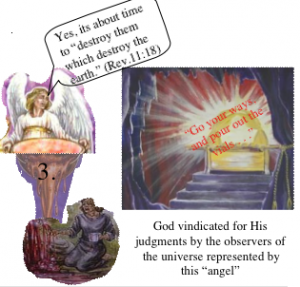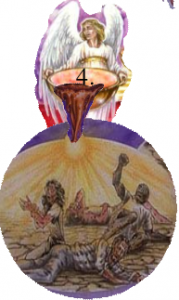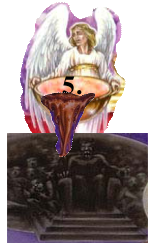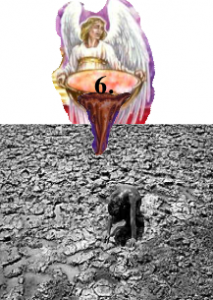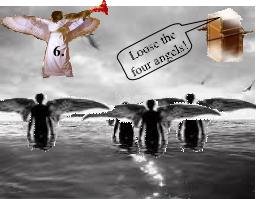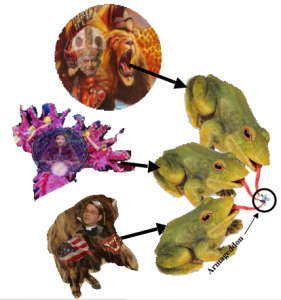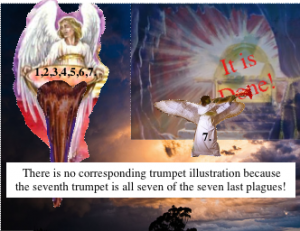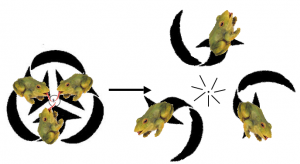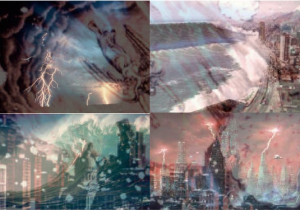There is little need to comment on the relationship of this chapter, to Chapter 15, since both deal with the “seven last plagues” on earth and the condition of things in the “temple . . . in heaven” (Revelation 15:5, 6, 8; 16:1, 17). It all happens while Jesus is coming to earth sitting on the great “white cloud” that He boarded (Revelation 14:14) just after he “cast” the “censer . . . into the earth” (Revelation 8:5).
Furthermore, Chapters 15 and 16 are the detailed “fleshing out” of the “third woe” (Revelation11:14-19), which is the last of the “seven trumpets” that were given the previous “seven angels which stood before God” (Revelation 8:2). Some believe the seven trumpets are the same as the seven last plagues. The differences will be shown as the plagues are described.
Therefore, when the “third woe” is finished, the great “white cloud” with its Divine Occupant will have arrived planet earth, causing “the heaven[s]” to depart “as a scroll when it is rolled together; and every mountain and island” will be “moved out of their places.” Then “the kings of the earth, and the great men, and the rich men, and the chief captains, and the mighty men, and every bondman, and every free man,” will hide “themselves in the dens and in the rocks of the mountains;” and say “to the mountains and rocks, Fall on us, and hide us from the face of him that sitteth on the throne, and from the wrath of the Lamb: For the great day of his wrath is come; and who shall be able to stand?” (Revelation 6:14-17)
Soon thereafter, “the time of the dead, that they should be judged” (Revelation 11:18) for a thousand years will begin as the saints sit upon “thrones . . . and judgment [will be] given unto them.” They will live and reign “with Christ a thousand years” (Revelation 20:4).
[Please note: anytime Abaddon is named, it also includes Apollyon, both impersonations of Satan (Revelation 9:11)]
Verse 1: And I heard a great voice out of the temple saying to the seven angels, Go your ways, and pour out the vials of the wrath of God upon the earth.
This “great voice out of the temple” must belong to God the Father whose “glory” filled “the temple” with “smoke” (Revelation 15:8), after His Son left the “temple” and stepped on board the great “white cloud” (Revelation 14:14). His direct command to the seven angels to empty “the vials” of His “wrath . . . upon the earth” coincides with the time when the 24 elders give “thanks” to God because He has taken back to Himself His “great power and hast reigned” (Revelation 11:17), after the “seventh trumpet” was sounded (Revelation 11:15). Therefore, the “seven last plagues” comprise God’s active/direct form of punishment, in contrast to the previous six trumpet plagues representing God’s indirect, [1] even passive, form of punishment. That began when God gave the “key” to the “star” (Satan) of the “bottomless pit” (Revelation 9:1), after Jesus threw down the censer (Revelation 8:5).
Therefore, “the vials of the wrath of God” will be “his strange work . . . his strange act” (Isaiah 28:21) which He does very infrequently. The most outstanding example of His “strange act” is the great “flood of waters” that God says “I, even I, do bring a flood of waters upon the earth, to destroy all flesh . . .” (Genesis 6:17).
Another example of God’s “active/direct” form of punishment was when “the Lord rained upon Sodom and upon Gomorrah brimstone and fire from the Lord out of heaven; and he overthrew those cities . . . and all the inhabitants of the cities . . .” (Genesis 19:24, 25). While there are other examples of God’s wrath, unmingled with mercy, these “vials of the wrath of God” comprise the last (premillennial) demonstration of His active/direct form of punishment, just before the second coming.
Verse 2: And the first went, and poured out his vial upon the earth; and there fell a noisome and grievous sore upon the men which had the mark of the beast, and upon them which worshipped his image.
The “first” plague of God’s wrath is directed, not only against the earth, but, against the beast/image” worshippers, and “mark” recipients. This close relationship between the “earth” and the false worshippers directs our attention back to where we see the two horned “beast coming up out of the earth,” compelling all to engage in this false worship (Revelation 13:11-18). Knowing that the two horned beast (commonly called the “earth beast”) represents the United States of America which came “up out of the [same] earth” we see here, is suggestive that God will vent the first manifestation of His seven-staged “wrath” specifically against our county and “the men” in our country “which had the mark . . .”
Why would God be so specific? Check out our discussion of the “vile person” who had “intelligence with them that forsake the holy covenant” (Daniel 11:30). As we learned there, the “forsakers” are representative of our country that once provided safe harbor for those desiring to escape the “vile person.” It then became instrumental in the final healing of the “deadly wound” (Revelation 13:3) that was inflicted upon the “vile person” back in 1798. Consequently, this country will be the recipient of the first manifestation of God’s overt anger.

This “noisome and grievous sore” that now falls upon these “men” is in stark contrast to the first trumpet which brought “hail and fire mingled with blood” that was “cast upon the earth” with “the third part of trees [being] burnt up, and all green grass . . . burnt up” (Revelation 8:7). At that point, the “earth” was “hurt” when Satan was given the power to do so. Now, these “men” who received the “mark” are hurt. The ignorant, who considered the study of Revelation of minor importance, and were only too willing to accept the traditional understandings, as many and confusing as they might be, will almost certainly believe Abaddon/Satan to be the one who caused these “noisome and grievous” sores. The fact that they come “upon . . . men” because they “had the mark” and “worshipped his image” will probably elude them. Having no alternative, they will “swear by the sin of Samaria, and say, Thy god, O Dan, [2] liveth; and, The manner of Beersheba liveth; even they shall fall, and never rise up again.” [3] [4] It could be paraphrased to read “Abaddon, you are the real God. Evidently, we were deceived by the other ‘god,’ Wormwood, whom you pretended to be. Now, these painful sores, for some reason, seem to manifest your displeasure with us. So, what do you want us to do?” In fact, they will “wander from sea to sea, and from the north even to the east . . . to seek the word of the LORD and shall not find it. In that day shall the fair virgins and young men faint for thirst” (Amos 8:12-14).
At this point, lets digress for a moment. “Satan . . . is a diligent student of the Bible, and is much better acquainted with the prophecies than many religious teachers. He knows that it is for his interest to keep well informed in the revealed purposes of God, that he may defeat the plans of the Infinite.” [5] The book of Revelation has probably received his most intense scrutiny and his basic strategy has been to distract and obfuscate. Keep men in ignorance, has been his plan and promote a “general reluctance to investigate its teachings” in order “to conceal from men that which reveals his deceptions. For this reason, Christ the Revelator, foreseeing the warfare that would be waged against the study of the Revelation, pronounced a blessing upon all who should read, hear, and observe the words of the prophecy.” [6] What a blessing it will be to the saints, especially at this point in time, if they understand the difference between the trumpets and the plagues!
They will know exactly that “the God of heaven” has just begun to manifest His displeasure against those who “had the mark of the beast, and upon them which worshipped his image.” If they had not been saying it before, during the previous trumpet scenarios, they will surely be saying it now “with a loud voice to him that sat on the cloud, Thrust in thy sickle, and reap: for the time is come for thee to reap; for the harvest of the earth is ripe” (Revelation 14:15).
Verse 3: And the second angel poured out his vial upon the sea; and it became as the blood of a dead man: and every living soul died in the sea.
Compare this scenario with “the second angel” who “sounded” his trumpet, followed by “a great mountain” being “cast into the sea: and the third part of the sea became blood; and the third part of the creatures which were in the sea, and had life, died; and the third part of the ships were destroyed.” (Revelation 8:8, 9).
In this second plague no “mountain” is depicted. Consider also that all the “sea” becomes “blood” instead of just a “third part.” Furthermore “every living soul died in the sea,” not just “a third.” Lastly, nothing is mentioned here about the destruction of any “ships.”
Verse 4: And the third angel poured out his vial upon the rivers and fountains of waters; and they became blood.
All the “sea” becoming a bloody mass, was bad enough, but when “the rivers” and springs become polluted, things become desperate. Therefore, this plague cannot be ignored. Even though “These plagues are not universal, or the inhabitants of the earth would be wholly cut off” “Yet they will be the most awful scourges that have ever been known to mortals.” [6] Therefore, we should consider them literal, making water unusable for drinking and even for irrigating crops. The saints, like the 144,000, will “have seen the earth wasted with famine and pestilence, the sun having power to scorch men with great heat, and they themselves have endured suffering, hunger, and thirst” [7] (Revelation 7:14-16). Part of that “suffering,” inclusive of “hunger and thirst,” must have been experienced during this plague.
Compare this scenario with the events associated with the third trumpet. When “the third angel sounded” his trumpet “there fell a great star from heaven” whose “name . . . is called Wormwood.” That “star,” represents a celestial being who caused “the third part of the rivers, and . . . the fountains of waters” to become “bitter” instead of bloody. There is no other parallel in the third plague, and we must conclude it to be a good deal different from the third trumpet.
Verse 5: And I heard the angel of the waters say, Thou art righteous, O Lord, which art, and wast, and shalt be, because thou hast judged thus.
This “angel of the waters” is the same “third angel” of Verse 4 who just “poured out his vial upon the rivers and fountains of waters.” That third plague deprived the wicked of their potable water supply. So here this angel springs to the defense of God for ordering such a dreadful thing. Therefore, even for angels, it is an awful sight to see men and women dying in this manner. But, the angel declares, God is “righteous” because He “hast judged thus.”
All through the ages, even “Before Christ’s first advent, the sin of refusing to conform to God’s law had become widespread. Apparently Satan’s power was growing; his warfare against heaven was becoming more and more determined. A crisis had been reached. With intense interest God’s movements were watched by the heavenly angels. Would He come forth from His place to punish the inhabitants of the world for their iniquity? Would He send fire or flood to destroy them? All heaven waited the bidding of their Commander to pour out the vials of wrath upon a rebellious world. One word from Him, one sign, and the world would have been destroyed. The worlds unfallen would have said, ‘Amen. Thou art righteous, O God, because Thou hast exterminated rebellion.’” [14] So, instead of punishing the world at that time for their growing, post flood apostasy, unselfish, undeserved love was extended to them. The angels were astonished. “With wonder and admiration they could only exclaim, ‘Herein is love.'” [ibid]
The question naturally arises, why is it necessary for God to pour out this additional misery upon the rebellious in the form of the “seven last plagues?” It would seem Satan’s devious manipulations of his followers would be punishment enough! The next two verses serve to answer that question.
Verse 6: For they have shed the blood of saints and prophets, and thou hast given them blood to drink; for they are worthy.
The pronoun “they” refers to “the men which had the mark of the [sea] beast, and . . . them which worshipped his image” (Verse 2). Therefore “they” represent the wicked who were guilty of murdering the “souls of them that were beheaded for the witness of Jesus, and for the word of God . . . which had not worshipped the beast, neither his image, neither had received his mark upon their foreheads, or in their hands” (Revelation 20:4). By now, we understand that those “souls” are the “fellowservants and their brethren” who were prophesied to “be killed as” were the martyrs of history when the “fifth seal” (Revelation 6:9-11) was opened. We also understand that to be indicative of the time when the Investigative Judgment of the dead passed to the living.
“Terrible as these [post probationary, third woe] plagues are, God’s justice stands fully vindicated. The angel of God declares, [Rev.16 :5, 6 quoted]. By condemning the people of God to death they have as truly incurred the guilt of their blood, as if it had been shed by their hands. In like manner Christ declared the Jews of his time guilty of all the blood of holy men which had been shed since the days of Abel; for they possessed the same spirit, and were seeking to do the same work, with these murderers of the prophets.” [15]
Verse 7: And I heard another out of the altar say, Even so, Lord God Almighty, true and righteous are thy judgments.
This is apparently the other “angel” (Revelation 14:15), representing the saints on earth, because Jesus will have left the “altar” in heaven when He stepped onto the great “white cloud” (Revelation14:14). [18]
In spite of experiencing, hunger, thirst, heat and the taunts and mocking from the wicked, they have nothing but praise for the “true and righteous . . . judgments” of God. They will have taxed the mind to understand and clearly define the book of Revelation [19]. Now, they will know without question the meaning of the things taking place in the world around them at this crucial stage in world history.
Verse 8: And the fourth angel poured out his vial upon the sun; and power was given unto him to scorch men with fire.
This verse takes up where “the third angel” left off (Verse 4). His vial contaminated “the rivers and fountains of waters” with “blood.” This one intensifies the sun’s radiation to such an extent “men” are scorched. This adds to the agony of those suffering under the effects of the third plague, and who are desperately searching for fresh water to quench their thirst and water their crops.
Compare this with “the fourth angel [who] sounded” his trumpet. There “the sun was smitten,” instead of intensified, evidently causing “the third part of the moon . . . stars . . . day . . . and the night” (Revelation 8:12) to be “darkened,” clear evidence that the fourth trumpet and the fourth plague are not the same, except that both take place during post probationary time.
What point does God have in strengthening the sun? Evidently, He is protesting the sun worship featured in the religion of the wicked, who like the apostates of ancient time turned “their backs toward the temple of the LORD, and their faces toward the east; and they worshipped the sun toward the east” (Ezekiel 8:16). Here, God, who can move the sun backwards or forward (see 2 Kings 20:9-11; Isaiah 38:8) with ease and even cause it to stand still (Joshua 10:12), can also intensify it.
Verse 9: And men were scorched with great heat, and blasphemed the name of God, which hath power over these plagues: and they repented not to give him glory.
Who are these “men” who “were scorched” and gave vent to their feelings by blaspheming “the name of God?” They must be “the men which had the mark of the beast, and . . . worshipped his image” (Verse 2). They were already blaspheming the name of God by attributing to man the prerogatives of God. But, not long before, when Abaddon, who was masquerading as Wormwood, caused “a great earthquake” that slew “seven thousand” men, “the remnant were affrighted, and gave glory to the God of heaven” (Revelation 11:13). Evidently, these same “men” who are now being “scorched with great heat . . . blasphemed the name of God” by attributing this inferno to Abaddon instead of “the God of heaven,” while at the same time uttering imprecations and oaths.
But, another class of men, those who will at last be “arrayed in white robes” and who will have come “out of [this] great tribulation” when “the sun light[ed] on them” (Revelation 7:14-16) and felt this same “great heat,” will yet give “glory to the God of heaven” in spite of their discomfort. They will have no doubt that this was God’s plague number four with only three remaining. Even though the “people of God will not be free from suffering” and “while they endure privation, and suffer for want of food . . . ‘the God of Israel will not forsake them’” [20] because they will not forsake Him.
Nevertheless, it will be a “fearful time: ‘The land mourneth . . . because the harvest of the field is perished.’ ‘All the trees of the field are withered; because joy is withered away from the sons of men.’ ‘The seed is rotten under their clods, the garners are laid desolate.’ ‘How do the beasts groan! the herds of cattle are perplexed, because they have no pasture . . . The rivers of waters are dried up, and the fire hath devoured the pastures of the wilderness.’ ‘The songs of the temple shall be howlings in that day, saith the Lord God; there shall be many dead bodies in every place; they shall cast them forth with silence.’” [21]
Seemingly, such desolation would bring extinction to the human race. However, “these plagues are not universal, or the inhabitants of the earth would be wholly cut off. Yet they will be the most awful scourges that have ever been known to mortals.” [22]
“Throughout the land there is a feverish but vain quest for a means of alleviating the suffering and want occasioned by the first four plagues and of averting further calamities. It is not motivated by godly sorrow, but by sorrow of the world. The objective is to escape the misery occasioned by the plagues, not to enter into a genuine state of reconciliation with God. Accordingly, Satan [who at this point must be Abaddon of Revelation 9:11] convinces the inhabitants of the earth, not that they are sinners, but that they have erred in tolerating God’s chosen people.” [23] [24] Consequently, the wicked, thinking God’s people “had brought the judgments upon them . . . rose up and took counsel to rid the earth of [them] thinking that then the evil would be stayed.” [25]
Verse 10: And the fifth angel poured out his vial upon the seat of the beast; and his kingdom was full of darkness; and they gnawed their tongues for pain,
By this point in time, the “seat of the beast” must be located “where also our Lord was crucified,” the same “city” where there was “a great earthquake” that destroyed a “tenth part” of the city and killed “seven thousand” “men” at the end of the “second woe” or sixth trumpet scenario (Revelation 11:8, 13, 14). That was when it was learned that Wormwood, the false Christ, was actually Abaddon, the destroyer. This is the place where evil men were laying plans to carry out the universal death decree to exterminate all who worshiped the true God and were resisting Abaddon’s rule. Little wonder that this plague was poured out specifically upon “the tabernacles” of the vile person’s “palace between the seas in the glorious holy mountain” ―Jerusalem (see Daniel 11:45).
The Commentary suggests this “is literal darkness” bringing with it “its attendant cold and misery” because of “the absence of light and heat.” That “would be all the more impressive and painful after the intense heat experienced under the fourth plague.” [26] So, again, the wicked are even more convinced that Abaddon, who diminished the sun in the fourth trumpet scenario (Revelation 8:12), has now diminished it again, just after intensifying it just previously in the fourth plague.
Compare this “fifth” plague bearing “angel” with the “fifth” trumpet bearing “angel” (Revelation 9:1-11) where John “saw a star fall from heaven unto the earth . . . the angel of the bottomless pit, whose name in the Hebrew tongue is Abaddon, but in the Greek tongue hath his name Apollyon.” He was the commander of the strange, locusts-horse-scorpion-like creatures who had the ability to torment “men.” which [had] not the seal of God in their foreheads,” for “five months.” Their sufferings were so severe that they “desire[d] to die” but “death” fled “from them.” Their suffering is similar to the anguish suffered in this plague, although there is no mention of a wish to die. As anybody knows how painful it is to accidentally bite the tongue, actually gnawing it to counter the pain of this plague, will indeed, be awful!
But, in spite of the similarities, this plague is not the same as the fifth trumpet, primarily because of the sequence involved and the fact that this scenario is a manifestation of God’s wrath after He began to “reign” and had “taken to [Himself His] great power” (Revelation 11:17).
On the other hand, the scenario of the fifth trumpet was one of the manifestations of Satan’s wrath when he used the army of his pale horse followers to goad those of the red horse into retaliating.
Verse 11: And blasphemed the God of heaven because of their pains and their sores, and repented not of their deeds.
While the “pains” came from the “fifth” angel’s “vial,” “their sores” must have come from “the effects of the first plague” [27] (Verse 2), suggesting those located at the “seat of the beast,” at least, suffered from two of the plagues even though they are not universal.
Note the attitude of the sufferers who “repented not of their deeds” like “that woman Jezebel” who “repented not” of “her fornication” (Revelation 2:21), and neither did “the rest of the men which were not killed by” the smoke, fire and brimstone of the sixth trumpet (Revelation 9:18) repent “of their murders . . . sorceries . . . fornication” or “thefts” (Revelation 9:21). This is more evidence that the “remnant” who survived the “great earthquake” and who “were affrighted” or terrified into giving “glory to the God of heaven” (Revelation 11:13), were not really sincere.
Those who claimed to be “Jews,” but were identified as the “synagogue of Satan” (Revelation 2:9; 3:9), the hypocritical philosophy of the people represented by the “red horse” followers of Wormwood (Revelation 6:4), have now abandoned that concept and are fully committed to the worship of Satan, the religion of the people represented by the “pale horse” (Revelation 6:8). They now worship Abaddon as the other false “God of heaven,” and to him they direct their complaints.
Verse 12: And the sixth angel poured out his vial upon the great river Euphrates; and the water thereof was dried up, that the way of the kings of the east might be prepared.
According to one view suggested in the Commentary: “the drying up of the waters of the Euphrates refers to the withdrawal of human support from mystical Babylon in connection with the sixth plague.” [28] That makes good sense. Additionally, the context places us at the point where the universal death decree has been planned and is now about to be executed.
Thus: “When the protection of human laws shall be withdrawn from those who honor the law of God, there will be, in different lands, a simultaneous movement for their destruction. As the time appointed in the decree draws near, the people will conspire to root out the hated sect. It will be determined to strike in one night a decisive blow, which shall utterly silence the voice of dissent and reproof . . . With shouts of triumph, jeering, and imprecation, throngs of evil men are about to rush upon their prey, when lo, a dense blackness, deeper than the darkness of the night, falls upon the earth. Then a rainbow, shining with the glory from the throne of God, spans the heavens, and seems to encircle each praying company. The angry multitudes are suddenly arrested. Their mocking cries die away. The objects of their murderous rage are forgotten. With fearful forebodings they gaze upon the symbol of God’s covenant, and long to be shielded from its overpowering brightness.” [29]
The arresting of the “angry multitudes” seen in that quote, must be the “drying up” of the “great river Euphrates.” Another parallel is where “the earth helped the woman, and the earth opened her mouth, and swallowed up the flood which the dragon cast out of his mouth” (Revelation 12:16).
Therefore, “the great river Euphrates” must represent, not only the “throngs of evil men” who “are about to rush upon their prey,” but all the wicked who approve of the awful decree, and even the rulers of the land who legislated the “decree,” including the “hour” of its execution.
Who then, are “the kings of the east?” Could they not represent those who brought the “tidings out of the east (as well as “out to the north”) in Daniel 11:44? We see there that those “tidings” enraged the “vile person” who went “forth with great fury to destroy and utterly to make away many.” That scenario, of course, took place prior to the casting down of the censer (see Revelation 8:5) and the beginning of the trumpet scenario. Now, at the time of the sixth plague, the “kings of the east” are soon to be released from the bondage thrust upon them by their persecutors, represented here by “the great river Euphrates.”
By the time the sixth of the seven plagues is poured out, there will be no neutral ground between the “great river” and the “kings of the east.” All will find themselves on the side of Abaddon or on the side of “the God of heaven.” All will either endorse the universal death decree or be a victim of it.
The reason for such a remarkable polarization of earth’s population is because the “kings of the east,” who were given the tremendous power of the Holy Spirit, were so successful in bringing the “tidings out of the east and out of the north” (Daniel 11:44) that “the knowledge of the Lord” covered the earth “as the waters cover the sea.” (Habakkuk 2:14) All, without exception, were given sufficient knowledge upon which to base an intelligent decision. The force of circumstances, such as the economic boycott that preceded the trumpet scenario, were such that all were compelled to make up their minds, before Jesus cast the “censer” “into the earth” (Revelation 8:5). The trumpet scenario, with the last being inclusive of all seven of the seven last plagues, served to demonstrate to the on-looking universe the real character and behavior of those who decided to accept the message of the eastern “kings,” and those who decided to reject it. None will be able to plead ignorance.
Compare this “sixth” plague bearing “angel” with the “sixth” trumpet bearing “angel,” whose trumpet blast warned that “the four angels” who were “bound in the great river Euphrates” were now “loosed” in order “to slay the third part of men” (Revelation 9:14). At that point, the “great river,” representing the human forces that support and protect mystical Babylon, was running strong. Now, with the pouring out of the “sixth . . . vial,” it is “dried up,” which is radically different from the sixth trumpet scenario.
Verse 13: And I saw three unclean spirits like frogs come out of the mouth of the dragon, and out of the mouth of the beast, and out of the mouth of the false prophet.
Here, John digresses from the order of the plague events before concluding with the final seventh “vial” (Verse 17). In the next three verses he looks back, retrospectively, at some things that took place during probationary time which culminated in the post probationary trumpet scenario, after the seventh seal was opened and Jesus threw down the censer (Revelation 8:1-5).
Jesus encountered “unclean spirits” several times during His earthly ministry. He, having far more power than they, always “cast them out” of whoever they were tormenting. He also shared His power with His followers, enabling them to do the same thing. (see Matthew 10:1; Mark 1:27; 3:11; 5:13; 6:7; Luke 4:36; 6:18; Acts 5:16; 8:7) On one occasion those “spirits claimed to be “Legion: for we are many” (Mark 5:9).
Here, only “three” are depicted and likened to “frogs” “probably . . . to highlight the repulsiveness” of these “spirits.” [30] Each of them hopped [31] “out” of the mouths “of the dragon . . . beast” and “false prophet.” Frogs possessing the unique ability to capture their prey with a specialized tongue that can extend out with lightning speed and remarkable distance, here represent the remarkable success these last day agents of Satan have had in capturing their human prey.
First-of-all, the “dragon . . . that old serpent, called the Devil, and Satan” (Revelation 12:9), gave the “beast . . . his power, and his seat and great authority” (Revelation 13:2) over the world which it retained for 1260 years. When “another beast,” that “had two horns like a lamb” (Revelation 13:11), representing the separation of church and state, [32] came “up out of the earth, sometime in 1776, (the birth of the United States of America), the world witnessed true freedom being exercised without the ecclesiastical control of the pope. Consequently, in 1798, “one of [the sea beast’s] [33] heads” was “wounded to death” when the pope was taken prisoner by the French.
The “dragon” was not happy with that development, and he influenced the earth beast to “speak like” himself and repudiate the principle of the separation of church and state. This was accomplished by dazzling the world with “great wonders,” even making “fire come down from heaven on the earth in the sight of men,” deceiving them with “miracles” because the “dragon” gave him that “power.” Along with those wonders he “had power to give life unto” an “image of the [sea] beast” (Revelation 13:11-15), causing it to “speak” the same “great things” it said during the previous “thousand two hundred and threescore days” (Revelation 12:6) of the Dark Age of history. The earth beast gained the dubious distinction of becoming the “false prophet” who created the “image” and “mark,” thus enabling the sea beast’s “deadly wound” to heal (Revelation 13:15-17).
Looking deeper, these “spirits” represent a confederation called the “threefold union.” Primary, among the “great errors” they espouse, are “the immortality of the soul, and Sunday sacredness . . .” Under the influence of those “great errors,” “Satan will bring the people under his deceptions. While the former lays the foundation of Spiritualism, the latter creates a bond of sympathy with Rome. The Protestants [the ‘false prophet’ the forsakers of the “holy covenant” (Daniel 11:30)] of the United States will be foremost in stretching their hands across the gulf to grasp the hand of Spiritualism; they will reach over the abyss to clasp hands with the Roman power; and under the influence of this threefold union, this country will follow in the steps of Rome in trampling on the rights of conscience.” [34] Therefore, the “immortality of the soul” and “Sunday sacredness” are examples of what could be likened to the remarkable “tongue” of these “spirits,” enabling them to capture their prey, which is the souls of men.
Prior to 1798, during the historic 1260 years of the Dark Age, only the “frogs out of the mouth of the dragon” and “the beast” existed. The “frog out of the mouth of the dragon” was overt paganism, and the one “out of the mouth of the beast” was Catholicism, such as seen on the head of the “fourth beast” occupied by ten pagan horns, plus the eleventh Christian(?), “little horn.”
Prior to 538, the field of battle was divided between two parties: true Christianity and the overt Paganism characterized by pagan Rome. [35] Therefore, during the period, between 31 and 538, only the “frog out of the mouth of the dragon” could be said to exist (in the metaphoric sense). It could be said that the “frog out of the mouth of the beast” came into existence and dominated the religious and political scene from 538 to 1798. It has only been since 1798 that the third party, called “the frog out of the mouth of the false prophet,” [36] has gradually emerged and has begun to join forces with the other two. Additionally, the frog from the mouth of the dragon has begun doing double duty as paganism for the Heathen, and spiritualism for the “Christian.”
Verse 14: For they are the spirits of devils, working miracles, which go forth unto the kings of the earth and of the whole world, to gather them to the battle of that great day of God Almighty.
Note that all three “spirits” of this false trinity work “miracles,” which they all have “power to do.” [37] “Satan has long been preparing for his final effort to deceive the world. The foundation of his work was laid by the assurance given to Eve in Eden: ‘Ye shall not surely die.’” That lie “prepared the way for his masterpiece of deception in the development of Spiritualism” which will be fully accomplished “in the last remnant of time. . . Except those who are kept by the power of God, through faith in His word, the whole world will be swept into the ranks of this delusion.” [38]
While most of us are aware of Satan’s “crowning act in the great drama of deception” [39] in which “Satan himself will personate Christ,” few, if any, have considered “Wormwood” to be the Biblical version of that delusion. Fewer still consider “Abaddon,” to be an extension of that final delusion. Because of preconceived ideas of what those names represent, rather than allowing the Bible to explain itself, coupled with fear of anything different, we have missed a very important insight into what the future holds for God’s people.
Consequently, many, thinking they know all they need to know, will find themselves “swept into the ranks of this delusion” almost against their will. “Only those who have been diligent students of the Scriptures, and who have received the love of the truth (2 Thessalonians 2:7-10), will be shielded from the powerful delusion that takes the world captive. By the Bible testimony these will detect the deceiver in his disguise. To all, the testing time will come . . . Are the people of God now so firmly established upon his Word that they would not yield to the evidence of their senses? Would they, in such a crisis, cling to the Bible, and the Bible only?” [40]
Such statements from White emphasize the crucial importance of the Biblical knowledge of the last days, not the least of which is the knowledge of the apocalyptic prophecies of Daniel and the Revelation. How else will we be able to “detect the deceiver [whose Biblical names will be “Wormwood” and “Abaddon”] in his disguise?” [41]
The term “day of God Almighty,” is synonymous with “day of the LORD” found some 26 times in the Bible. Generally speaking, it is a time of reckoning, when the Lord calls men to account for their wickedness. For example, it is a time when “every one that is proud . . . shall be brought low (Isaiah 2:12); a time that is “cruel” (Isaiah 13:9), a time “of the Lord’s vengeance” (Isaiah 34:8), His “anger” (Lamentations 2:22), it is “very terrible” (Joel 2:11), a day of “darkness” (Amos 5:20), “wrath” (Zephaniah 1:18), etc. The essence of the phrase “day of God Almighty” could be thought to harmonize with the figurative “bottomless pit” (Revelation 9:1, 2, 11; 11:7; 17:8; 20:1, 3.) of post probationary time. That metaphor is descriptive of the spiritual situation of the whole world after Jesus casts “the censer into the earth” (Revelation 8:5). After that, the “seven angels which stood before God” that were “given seven trumpets” will begin to sound them one-by-one (see Revelation 8:2, 6), with the last trumpet culminating in the seven last plagues.
Verse 15: Behold, I come as a thief. Blessed is he that watcheth, and keepeth his garments, lest he walk naked, and they see his shame.
This is the same warning given “the church in Sardis” who had “a name that thou livest, and art dead.” Jesus said “If therefore thou shalt not watch, I will come on thee as a thief, and thou shalt not know what hour I will come upon thee” (Revelation 3:1-3), implying they could know the “hour” if they were watching.
“One saying of the Saviour must not be made to destroy another. Though no man knoweth the day nor the hour of his coming, we are instructed and required to know when it is near. We are further taught that to disregard his warning, and refuse or neglect to know when his advent is near, will be as fatal for us, as it was for those who lived in the days of Noah not to know when the flood was coming.” [42] In that case, “knowing the hour” suggests we will know it when it comes rather than being able to predict it beforehand. If we neglect watching, we will not know it even when it does come! And, as the analogy reads, we will be found “naked” and others will see us “shamed.”
Therefore, the “thief” analogy is a warning to those who fail to realize the nearness of His coming. Right at the beginning of John’s vision, which came to him some 2,000 years ago, some of the first words were: “the time is at hand” (Revelation 1:3) and “Behold I come quickly” (Revelation 3:11). Some mock, asking how such an ancient warning could be quick, not realizing that time stops at death for each and every individual. After that the judgment will come and all will find themselves lofted into heaven at the time of the “first resurrection” (Revelation 20:5,6) [43] or standing outside “new Jerusalem” at the time of “the second death” (Revelation 2:11; 20:6, 14; 21:8). From that perspective, Christ’s coming will indeed be quicker than we could possibly imagine!
This warning is especially designed for those who will be alive when these “three unclean spirits” begin “working miracles” in order to “gather” “the whole world . . . to the battle of that great day of God Almighty.” “The Lord calls upon those who believe in him to be workers together with him. While life shall last, they are not to feel that their work is done. Shall we allow the signs of the end to be fulfilled without telling people of what is coming upon the earth? Shall we allow them to go down in darkness without having urged upon them the need of a preparation to meet their Lord? Unless we ourselves do our duty to those around us, the day of God will come upon us as a thief. Confusion fills the world, and a great terror is soon to come upon human beings. The end is very near. We who know the truth should be preparing for what is soon to break upon the world as an overwhelming surprise.” [44]
Instead of confusion, “Blessed is he that readeth, and they that hear the words of this prophecy, and keep those things which are written therein: for the time is at hand” (Revelation 1:3). “To John were opened scenes of deep and thrilling interest in the experience of the church . . . Subjects of vast importance were revealed to him, especially for the last church, that those who should turn from error to truth might be instructed concerning the perils and conflicts before them. None need be in darkness in regard to what is coming upon the earth.” [45] And it is vital for us, as well as for those around us, to share these things.
Verse 16: And he gathered them together into a place called in the Hebrew tongue Armageddon.
Who is “he?” If we accept the personal pronoun “he,” as written, it would direct us to the sixth angel of Verse 12 whose plague serves to dry up and disperse rather than gather. The comment in the Commentary is helpful here. It suggests that “the Greek may be translated either way” as “he” or “they.” It further declares that “The context favors the translation ‘they.’ For the gathering process see on v. 14.” [46] There, we see the “three unclean spirits” of Spiritualism, the Roman power and apostate Protestantism, the instruments in the hand of Satan used to gather together the disparate nations of the “whole world” into the “threefold union.” It is only when the sixth angel pours out his plague that this union will fall apart.
This “threefold union” brings “the whole world . . . together into a place called . . . Armageddon.” [47] If it were a literal “place,” namely “in the literal valley of Megiddo, in northern Palestine” on “that great day of God Almighty,” [48] it is inconceivable that that “place” has room for all six billion of earth’s inhabitants, much less keep them there while fighting for any period of time! Therefore, it seems far more reasonable to assume this “place called . . . Armageddon,” is figurative of a “’condition,’ or frame of mind, into which the kings of the earth” as well as the “whole world” come to believe it is necessary to “annihilate the people of God.” [49]
Consider these statements:
(1) “Four mighty angels hold back the powers of this earth till the servants of God are sealed in their foreheads. The nations of the world are eager for conflict; but they are held in check by the angels. When this restraining power is removed, there will come a time of trouble and anguish. Deadly instruments of warfare will be invented. Vessels, with their living cargo, will be entombed in the great deep. All who have not the spirit of truth will unite under the leadership of Satanic agencies. But they are to be kept under control till the time shall come for the great battle of Armageddon.” [50]
(2) “We need to study the pouring out of the seventh vial. The powers of evil will not yield up the conflict without a struggle. But Providence has a part to act in the battle of Armageddon. When the earth is lighted with the glory of the angel of Revelation 18, the religious elements, good and evil, will awake from slumber, and the armies of the living God will take the field.” [51]
(3) “The mighty angel from heaven, is to ‘lighten the earth with his glory,’ (Revelation 18:1) while he cries mightily with a loud voice, ‘Babylon the great is fallen, is fallen’ (Verse 2) . . . Every form of evil is to spring into intense activity. Evil angels unite their powers with evil men, and, as they have been in constant conflict and attained an experience in the best modes of deception and battle, and have been strengthening for centuries, they will not yield the last great final contest without a desperate struggle. All the world will be on one side or the other of the question. The battle of Armageddon will be fought, and that day must find none of us sleeping.” [52]
(4) “The battle of Armageddon will be fought. And that day must find none of us sleeping. Wide awake we must be, as wise virgins having oil in our vessels with our lamps. The power of the Holy Ghost must be upon us and the Captain of the Lord’s host will stand at the head of the angels of heaven to direct the battle. Solemn events before us are yet to transpire. Trumpet after trumpet is to be sounded; vial after vial poured out one after another upon the inhabitants of the earth. Scenes of stupendous interest are right upon us and these things will be sure indications of the presence of Him who has directed in every aggressive movement, who has accompanied the march of His cause through all the ages, and who has graciously pledged Himself to be with His people in all their conflicts to the end of the world. He will vindicate His truth. He will cause it to triumph. He is ready to supply His faithful ones with motives and power of purpose, inspiring them with hope and courage and valor in increased activity as the time is at hand.” [53]
(5) “John writes, ‘I beheld, and I heard the voice of many angels round about the throne.’ Angels were united in the work of Him who had broken the seals and taken the book. Four mighty angels hold back the powers of this earth till the servants of God are sealed in their foreheads. The nations of the world are eager for conflict; but they are held in check by the angels. When this restraining power is removed, there will come a time of trouble and anguish. Deadly instruments of warfare will be invented. Vessels, with their living cargo, will be entombed in the great deep. All who have not the spirit of truth will unite under the leadership of satanic agencies. But they are to be kept under control till the time shall come for the great battle of Armageddon.” [54]
The “four mighty angels” of statements (1) and (5) refer to the probationary scenario (Revelation 7:1). Both suggest that “the great battle of Armageddon” begins when they release their hold on the “four winds,” signaling the sounding of the “seven trumpets” which also inaugurates the “battle of Armageddon.”
Statement (2) is not quite so clear. While it connects the “battle of Armageddon” with the post probationary scenario of the “seventh vial,” it also associates it with the “loud cry” scenario (Revelation18) that will cause a tremendous reaction in the religious world during probationary time!
Statement (3) first depicts the loud cry scenario (Revelation 18), then implies that the “battle of Armageddon” will take place subsequent to that when “all the world will be on one side or the other of the question” lodged by the loud cry. Evidently, during post probationary time.
Statement (4) is almost definitive! It clearly associates the “battle of Armageddon” with all the trumpets and the vials!
In summary, neither the Bible nor White connect the “battle of Armageddon” with a single battle or a single geographic location on the earth. Instead, it appears very likely that the “battle of Armageddon” covers the world-wide, post probationary period of time portrayed by the “seven trumpets” of Revelation. [55]
Verse 17: And the seventh angel poured out his vial into the air; and there came a great voice out of the temple of heaven, from the throne, saying, It is done.
This verse brings to an end the parenthetical, retrospective scenario of the three miracle working spirits (Verses 13 to 16) and reconnects us with the last of the “seven last plagues.”
The “vial” of the “sixth angel” brought the onrushing hoard of the wicked, represented by “the great river Euphrates,” who were bent on annihilating the people of God, to a dead stop. But God isn’t finished. He commands the pouring out of just one more “vial,” the seventh. Five verses (17-21) are required to cover that plague.
While the previous six were poured out on “the earth, the sea, the rivers and fountains, the sun, the seat of the beast” and finally, “the great river Euphrates,” this plague is poured out “into the air” or “upon the air” suggesting it has something to do with the atmosphere. The Commentary suggests: “The effect of this plague appears to be universal” [56] which seems reasonable because no plague is to follow. The earth is to receive its final blow.
Very likely, during the interval between the sixth and seventh vials when “the great river Euphrates” [is] dried up,” the “synagogue of Satan, which say they are Jews, and are not, but do lie . . . will . . . come and worship before [the] feet” (Revelation 3:9) of the saints, finally recognizing that God had loved them all along. [57] But, sadly, their repentance brings no more benefit to them than the people represented by the red horse who “were affrighted, and gave glory to the God of heaven” (Revelation 11:13). The events of the “third woe” (Revelation 11:14) that followed their acknowledgment, proved it hollow.
The “great voice out of the temple of heaven,” must be from God the Father whose “glory” “filled” the “temple” like “smoke” preventing the entrance (by faith) of any man while “the seven plagues of the seven angels” (Revelation 15:8) were being poured out, implying that literal entrance will become possible after the seventh plague “is done.” According to our understanding, the other “angel” who “came out of the temple” represents the saints on earth who followed Jesus by faith as He took His place on the great “white cloud” (Revelation 14:14, 15). Therefore, from the time Jesus “came and stood at the altar” in the heavenly temple and “took the censer, and filled it with fire of the altar, and cast it into the earth” (Revelation 8:3,5), signaling the sounding of the seven trumpets, the saints knew exactly what was transpiring. They knew that Jesus had left the temple and was now on His way earthward. He was no longer in the temple in heaven. Soon after the last plague and after Jesus had taken the saints to heaven, they “were about to enter the holy temple, [when] Jesus raised his lovely voice and said, ‘only the 144,000 enter this place’ . . .” [58]
The decisive words “It is done” are uttered by God the Father “out of the temple in heaven.” As we noted in Revelation 10:7, “in the days of the voice of the seventh angel [7th trumpet], when he shall begin to sound, the mystery of God should be finished . . .” Knowing that this “seventh [trumpet] angel” is inclusive of all seven of the seven last plagues, we can see that erasing the “mystery” of who the true God really is took a number of plagues. In fact, the “mystery” was not completely erased even after the sixth plague (Verse 12) caused the drying up of the “great river Euphrates.” Note, again, that the eradication of the mystery takes place sometime during “the days of the voice of the seventh [plague] angel,” not immediately.
Obviously, it will be “finished” at the point when the great “white cloud,” that was transporting “one like unto the Son of man,” will have arrived planet earth. Its passage caused the atmosphere to depart “as a scroll when it is rolled together; and every mountain and island were moved out of their places. And the kings of the earth, and the great men, and the rich men, and the chief captains, and the mighty men, and every bondman, and every free man, hid themselves in the dens and in the rocks of the mountains; And said to the mountains and rocks, Fall on us, and hide us from the face of him that sitteth on the throne, and from the wrath of the Lamb: For the great day of his wrath is come; and who shall be able to stand?” (Revelation 6:14-17)
Verse 18: And there were voices, and thunders, and lightnings; and there was a great earthquake, such as was not since men were upon the earth, so mighty an earthquake, and so great.
These are the same things depicted in Revelation 11:19 when “the temple of God was opened in heaven, and there was seen in his temple the ark of his testament: and there were lightnings, and voices, and thunderings, and an earthquake, . . .” [59]
This earthquake will be the worst by far that has ever struck the earth. As noted in Revelation 6:14 “every mountain and island [will be] moved out of their places” and in Verse 20 of this chapter, “every island fled away, and the mountains were not found.” Jeremiah “beheld the earth, and, lo, it was without form, and void; and the heavens, and they had no light. I beheld the mountains, and, lo, they trembled, and all the hills moved lightly. I beheld, and, lo, there was no man, and all the birds of the heavens were fled. I beheld, and, lo, the fruitful place was a wilderness, and all the cities thereof were broken down at the presence of the LORD, and by his fierce anger. For thus hath the LORD said, The whole land shall be desolate; yet will I not make a full end.” (Jeremiah 4:23-27) The “full end” comes at least a “thousand years” later. (See Revelation 20:14, 15)
Verse 19: And the great city was divided into three parts, and the cities of the nations fell: and great Babylon came in remembrance before God, to give unto her the cup of the wine of the fierceness of his wrath.
The three-part city is depicted as the “threefold union” of Spiritualism, Catholicism and apostate Protestantism (Verses 13, 14), or as the Commentary suggests “mystical Babylon.” [60] Now it has lost “its cohesion, unity, and power to act.” [61]
“The people see that they have been deluded. They accuse one another of having led them to destruction; but all unite in heaping their bitterest condemnation upon the ministers. Unfaithful pastors have prophesied smooth things; they have led their hearers to make void the law of God and to persecute those who would keep it holy. Now, in their despair, these teachers confess before the world their work of deception. The multitudes are filled with fury. ‘We are lost!’ they cry, ‘and you are the cause of our ruin;’ and they turn upon the false shepherds. The very ones that once admired them most, will pronounce the most dreadful curses upon them. The very hands that once crowned them with laurels, will be raised for their destruction. The swords which were to slay God’s people, are now employed to destroy their enemies. Everywhere there is strife and bloodshed.” [62]
Why such carnage? It is because “the mystery of God,” referred to by the “mighty angel” John “saw stand upon the sea and upon the earth [who] lifted up his hand to heaven, and sware by him that liveth for ever and ever . . . that there should be time no longer,” is finished. So, “in the days of the voice of the seventh [trumpet] angel [or ‘third woe’], when he shall begin to sound, the mystery of God should be finished . . . .” (Revelation 10:7, italics supplied). Now it is abundantly clear to the wicked that they have been completely duped by Wormwood and Abaddon and, to their horror, find themselves hopelessly cast into the “bottomless pit” (Revelation 9:1,2, 11; 11:7; 17:8 and 20:1,3).
Meanwhile, besides the clashing of the “dark, heavy clouds,” the cessation of the streams of water, etc., in “the midst of the angry heavens . . . one clear space of indescribable glory” appeared from “whence comes the voice of God . . . saying, ‘It is done.’” Then “Prison walls are rent asunder, and God’s people, who have been held in bondage for their faith, are set free. Graves are opened, and ‘many of them that sleep in the dust of the earth . . . awake, some to everlasting life, and some to shame and everlasting contempt.’ [Dan. 12:2.] All who have died in the faith of the third angel’s message come forth from the tomb glorified, to hear God’s covenant of peace with those who have kept his law. ‘They also which pierced Him,’ [Rev. 1:7.] those that mocked and derided Christ’s dying agonies, and the most violent opposers of his truth and his people, are raised to behold him in his glory, and to see the honor placed upon the loyal and obedient.” [63]
Verse 20: And every island fled away, and the mountains were not found.
“The glory from the throne of God seems flashing through. The mountains shake like a reed in the wind, and ragged rocks are scattered on every side. There is a roar as of a coming tempest. The sea is lashed into fury. There is heard the shriek of the hurricane, like the voice of demons upon a mission of destruction. The whole earth heaves and swells like the waves of the sea. Its surface is breaking up. Its very foundations seem to be giving way. Mountain chains are sinking. Inhabited islands disappear. The seaports that have become like Sodom for wickedness, are swallowed up by the angry waters.” [64]
Perhaps the flooding of the “seaports” and the disappearing “islands” might be due to the melting of the snow and ice in Greenland and the Antarctic because of the increased power of the sun during the fourth plague when “men were scorched with great heat.” If so, “global warming” will have become an awesome reality.
Far better to risk the wrath of men, who enforce compliance with their evil schemes, than to risk the “strange act” (Isaiah 28:21) of God, depicted in these plagues, who “will not always . . . keep his anger forever” (Psalms 103:9).
Verse 21: And there fell upon men a great hail out of heaven, every stone about the weight of a talent: and men blasphemed God because of the plague of the hail; for the plague thereof was exceeding great.
Comparing this with the first trumpet (Revelation 8:7), we also find “hail” there. But it is “mingled with blood” as well as “fire.” In contrast, no “blood” or “fire” is mentioned anywhere in this seventh plague scenario. Also, in comparison to the
first trumpet, where only “the third part of trees” are “burnt up, and all green grass was burnt up,” far more devastation takes place during this final scenario of the “seventh” plague bearing “angel” who “poured out his vial into the air” (Verse 17), instead of the “earth.”
This verse focuses on “a great hail out of heaven,” clearly the same “great hail” described as coming after the seventh angel sounded his trumpet (Revelation 11:19). Like the “hail” of this verse, it too was accompanied by “lightnings, and voices, and thunderings, and an earthquake” that we see in this chapter. Therefore, this must be the final event of the “third woe” scenario (Revelation 11:14), indicating that the “third woe” (seventh trumpet) must be inclusive of all seven of the seven last plagues. It also depicts the “four and twenty elders” expressing feelings of joy and relief “because” God has retaken to Himself His “great power” (Revelation 11:14-21) that was previously relinquished to Satan during the first six trumpet episodes.
This view then looks down to earth to exhibit the anger of earthly “nations” because God’s “wrath is come,” a change that was completely unexpected. It was unexpected because the “nations” were looking forward to a thousand years of peace and prosperity. Instead, these devastating plagues indicate calamity instead of prosperity. Thinking themselves to be punished by Abaddon, they, under the influence of Satan, make God’s people the scapegoat and determine to eradicate them from the face of the earth.
With each “stone” weighing somewhere between 100 and 200 pounds, [65] all life, it would seem, would be totally extinguished. Nevertheless, because these plagues are not universal, many survive to see Jesus come “with clouds; and every eye shall see him” (Revelation 1:7).
Check out these statements and compare them with The Great Controversy. [66] They show that the primary application of the “third woe” is future rather than history. “Tell the people that the Lord is coming in judgment, and that neither rulers nor kings, wealth nor influence, will be able to stand against or ward off the judgments soon to fall. In many places these judgments are already falling, yet by their attitude worldlings and church members say plainly, We want none of these rebukes. We want none of your warnings. We will not hear. [Par.] ‘And the temple of God was opened in heaven, and there was seen in His temple the ark of His testament: and there were lightnings, and voices, and thunderings, and an earthquake, and great hail [Rev. 11:19].’” [67]
“Writing of the last days, John says: ‘The nations were angry, and Thy wrath is come, and the time of the dead, that they should be judged, and that Thou shouldest give reward unto Thy servants the prophets, and to the saints, and them that fear Thy name, small and great; and shouldest destroy them which destroy the earth. And the temple of God was opened in heaven, and there was seen in His temple the ark of His testament: and there were lightnings, and voices, and thunderings, and an earthquake, and great hail.’” [68]
Summary of Chapter 16: This chapter itemizes the “seven last plagues” scenario referred to in Chapter 15:1, 5-8. While Revelation 15:2-4 depicts the reward of the righteous who overcame “the beast, image, mark” and “number” paradigm, which is the “test that the people of God must have before they are sealed” and further illustrated by the metaphoric frogs in Revelation 16:13-16, this chapter is devoted entirely to a portrayal of the reward of the wicked “which had the mark of the beast” and “worshipped his image” (Revelation 16:2) during the last phase of the post probationary, pre millennial executive judgment paradigm of the seven trumpets. Attention is called to the parallels existing between Revelation 11:19 and 15:1, 5-8 and 16:1-12, 17-21 reminding us that the “third woe” or “seventh” trumpet (Revelation 11:14, 15) that comes “quickly” after the “second woe is past,” includes all seven of “the seven last plagues” [69], depicted in this chapter, with both ending with “lightnings, and voices, and thunderings and an earthquake, and great hail” (Revelation 11:19) and “voices, and thunders, and lightnings . . . a great earthquake” and “a great hail” (Revelation 16:18, 21). Attention is also called to the fact that this seventh angel/third woe scenario is the time when “the mystery of God [will] be finished” “in the days of the voice of the seventh angel” (Revelation 10:7).
………………………………………………………………………………………………………………………………………………
[1] “Indirect,” because God, by releasing the “four winds of the earth” (see Revelation 7:1), had given entire control of the wicked over to Satan. Here, He retakes control during the seven last plagues.
[2] Remember, “Dan” is one of the missing names in the list of the 144,000, and he, featured “like a flying eagle,” the fourth beast (Revelation 4:7), introduces the “pale horse” (Revelation 6:7, 8) saying “Come and see.”
[3] See Amos 8:11-14. One of the things the Commentary says about this passage, is: “In the final ‘day of the Lord,” just before the second advent of Christ, this experience of ancient Israel will be repeated, when the impenitent of the whole earth, suffering under the seven last plagues, will seek relief from calamity by any means possible, even turning to the Word of God, which they had formerly neglected to study and obey (see GC 629).” (Seventh-day Adventist Bible Commentary, Vol. 4, page 980, right column under “11. Send a famine.” Second paragraph)
[4] “In that day, multitudes will desire the shelter of God’s mercy which they have so long despised. [Amos 8:11, 12 quoted].” At the same time “The people of God will not be free from suffering; but while persecuted and distressed, while they endure privation, and suffer for want of food, they will not be left to perish.” (The Great Controversy by E.G White, page 628, 629)
[5] Review and Herald, 08, 3-3-1874
[6] The Great Controversy by E.G. White, page 342
[7] Maranatha by E.G. White, page 328
[8-13] (deleted)
[14] Signs of the Times 8-27-02 (italics supplied)
[15] The Great Controversy by E.G. White, page 627 [brackets mine]
[16-17] (deleted)
[18] See again: Word to the Little Flock by E.G. White, page 12.
[19] see Manuscript Releases Vol. 12, pages 212, 213
[20] The Great Controversy by E.G. White, page 629
[21] Ibid, page 628 (quoting Revelation 16:2-6, 8, 9; Joel 1:10-12; 17-20. Ellipses not supplied)
[22] Ibid 628, 629
[23] Seventh-day Adventist Bible Commentary, Vol. 7, page 841 (top right column [bracket supplied])
[24] It is unlikely Satan, as Abaddon, will identify the dissenters as “God’s chosen people,” rather they will be identified as troublemakers and irreconcilable nonconformists with the “new world order” who must be irradicated before he is willing to stop these dreadful plagues.
[25] see Early Writings by E.G. White, page 33.
[26] Seventh-day Adventist Bible Commentary, Vol. 7, page 842 (left column under “Darkness.”)
[27] Ibid (left column under “Their sores.”)
[28] Seventh-day Adventist Bible Commentary, Vol. 4, page 843 (bottom right column, second paragraph, under “Dried up.”) The Commentary suggests as a corollary reading, The Great Controversy by E.G White, pages 654 to 656. However, page 635 and onward seems more applicable.
[29] Ibid, pages 635, 636
[30] Seventh-day Adventist Bible Commentary, Vol. 7, page 844 (right column under “Like frogs.”)
[31] Since the word “come” is italicized, it is legitimate to substitute “hopped,” because that is how frogs move about.
[32] Other things are represented, as well, such as “Protestantism” and “Republicanism,” but the primary thing is the separation of church and state. If that goes away, so do all the other freedoms we enjoy!
[33] Remember, in our study of Revelation 13, I call the beast of verses 1-10 the “sea beast” because he came up from the sea; the beast of Revelation 13:11 is the “earth beast” because that is where he came from.
[34] The Great Controversy by E.G. White, page 588 (ellipse, bracket and italics supplied)
[35] That is, excluding the Jewish nation whose influence against Christianity since 31 A.D. rapidly diminished.
[36] called “them that forsake the holy covenant” in Daniel 11:30
[37] See Revelation 13:14. Although this specifically applies to the “earth beast,” since he is able to “give life unto the image,” the beast obviously accepts spiritualism. It is common knowledge that one of the qualifications for sainthood is the documentation of at least one miracle by that “saint.”
[38] The Great Controversy by E.G. White, pages 561, 562 (ellipses supplied)
[39] Ibid, page 624
[40] Ibid, page 625 (italics & ellipse supplied)
[41] But, don’t expect Satan to use those names! He is too smart for that. His name for “Wormwood” will be “Jesus of Nazareth.” Perhaps the name he uses for “Abaddon” will be some kind of macho name like Darth Varder????
[42] The Great Controversy by E.G. White, page 370 (italics not supplied)
[43] Of course, no “mocker” will be resurrected at that time!
[44] Advent Review and Sabbath Herald, 11-22-06
[45] The Great Controversy by E.G. White, page 341
[46] Seventh-day Adventist Bible Commentary, Vol. 7, page 845 (right column under “16. He gathered.”)
[47] See verses 14-16. Note that the pronoun “them” must refer to the “whole world” (Verse 14).
[48] This is only one of the two possibilities referred to in the Seventh-day Adventist Bible Commentary, Vol. 7, page 845 (right column)
[49] Ibid (under “Place.”) Note that I have paraphrased this wording somewhat.
[50] Manuscript Releases by E.G. White, Vol. 1 page 145; Seventh-day Adventist Bible Commentary, Vol. 7, page 967 (italics supplied)
[51] Ibid, Vol. 19, page 160 (italics supplied)
[52] Ibid, Vol. 8, pages 346, 347 (italics supplied)
[53] Selected Messages by E.G. White, Vol. 3 page 426 (italics supplied)
[54] Seventh-day Adventist Bible Commentary, Vol. 7, page 967 (italics supplied)
[55] Naturally, those who hold to the historic application of the seven trumpets will not give this explanation much, if any, credence and will tend to favor the single “place” application. Be-that-as-it-may, remember that the seventh trumpet (or “third woe” Revelation 11:14) is composed of all seven of the seven last plagues.
[56] Seventh-day Adventist Bible Commentary, Vol. 7, page 846 right column (under “Into the air”) and also could be read “upon the air.”
[57] “You think, that those who worship before the saint’s feet, (Revelation 3:9), will at last be saved. Here I must differ with you, for God shew me that this class were professed Adventists, who had fallen away, and ‘crucified to themselves the Son of God afresh, and put him to an open shame.’ And in the ‘hour of temptation,’ which is yet to come, to show out every one’s true character, they will know that they are forever lost; and overwhelmed with anguish of spirit, they will bow at the saint’s feet.” (Word To the Little Flock by E.G. White, page 12)
[58] Early Writings by E.G. White, page 19 (italics supplied)
[59] Note that through all of the previous 6 plagues, the true God in heaven is not recognized until the very last one when God the Father announces, “it is done.” Then, in verse 18, Jesus arrives planet earth on the great “white cloud” depicted in Revelation 14:14.
[60] Seventh-day Adventist Bible Commentary, Vol. 7, page 847 (left column under “19. The great city.”)
[61] Ibid
[62] The Great Controversy by E.G. White, pages 655, 656
[63] Ibid, page 636, 637 (ellipses supplied)
[64] Ibid
[65] a “talent” from: “talantiaios” (Strong’ #5006) “a talent of silver = 100 pounds; a talent of gold = 200 pounds” (Online Computor Lexicon)
[66] The Great Controversy by E.G. White, page 433 reads: “’The temple of God was opened in Heaven, and there was seen in his temple the ark of his testament.”[Rev. 11:19.] The ark of God’s testament is in the holy of holies, the second apartment of the sanctuary. In the ministration of the earthly tabernacle, which served ‘unto the example and shadow of heavenly things,’ this apartment was opened only upon the great day of atonement, for the cleansing of the sanctuary. Therefore the announcement that the temple of God was opened in Heaven, and the ark of his testament was seen, points to the opening of the most holy place of the heavenly sanctuary, in 1844, as Christ entered there to perform the closing work of the atonement.” (note the omission of the last half of verse 19) Therefore, in this statement, White ignores the context in order to point out the reality of what happened in 1844, something a prophet is fully qualified to do.
[67] Manuscript Releases by E.G. White, Vol. 14, page 161 (italics supplied)
[68] Manuscript Releases by E.G. White, Vol. 20, page 221; see also Battle Creek Letters by E.G. White, page 57. These statements make it clear (at least to my mind) that White understood that the “third woe” or “seventh angel” of Revelation 11:14-19 is parallel to the seven last plague scenario of Revelation 15 and 16.
[69] This simple diagram might be helpful for understanding the relationship between the “third woe” and the “seven last plagues”:
(Correction: The first reference should be Revelation 11:14)
